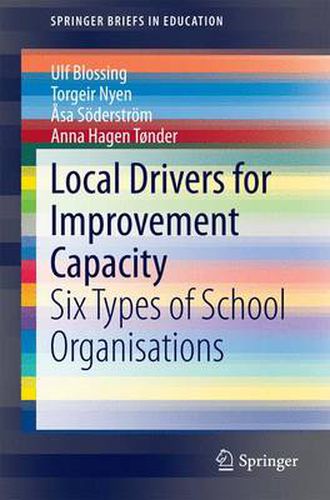Readings Newsletter
Become a Readings Member to make your shopping experience even easier.
Sign in or sign up for free!
You’re not far away from qualifying for FREE standard shipping within Australia
You’ve qualified for FREE standard shipping within Australia
The cart is loading…






This title is printed to order. This book may have been self-published. If so, we cannot guarantee the quality of the content. In the main most books will have gone through the editing process however some may not. We therefore suggest that you be aware of this before ordering this book. If in doubt check either the author or publisher’s details as we are unable to accept any returns unless they are faulty. Please contact us if you have any questions.
This book presents systematically six types of schools, with different improvement capacities. Different schools have different capacities for school improvement, depending on the school infrastructure, norms and routines for the improvement process, improvement roles, and improvement history. The organisation of the improvement capacity is understood on the basis of sensemaking processes among teachers and school leaders. The book focuses on the challenges for each type of school in their improvement work, and which situations and circumstances they need to take into account. The school types are illustrated with detailed descriptions of six schools, coming from an evaluation of a Norwegian school development program. The book fills a need in school organisations to have concrete illustrations from similar schools of how teacher teams are organised, how leadership is exercised and processes are organised in their efforts of improving the organisation and building a complex and effective capacity. Schools’ improvement capacity has become an important feature in school management and leadership as well as in research as western states have decentralised governance to the local level. The expectations on school leaders as well as on teachers are high when it comes to improve their schools to raise student outcome. Accounts of professional school cultures and professional learning communities often describe in an overall perspective the ideal school where such an improvement capacity is in work. However, accounts of the many ways of organising the capacity which perhaps are not all in all ideal or effective also contribute to the knowledge of the local school process.
$9.00 standard shipping within Australia
FREE standard shipping within Australia for orders over $100.00
Express & International shipping calculated at checkout
This title is printed to order. This book may have been self-published. If so, we cannot guarantee the quality of the content. In the main most books will have gone through the editing process however some may not. We therefore suggest that you be aware of this before ordering this book. If in doubt check either the author or publisher’s details as we are unable to accept any returns unless they are faulty. Please contact us if you have any questions.
This book presents systematically six types of schools, with different improvement capacities. Different schools have different capacities for school improvement, depending on the school infrastructure, norms and routines for the improvement process, improvement roles, and improvement history. The organisation of the improvement capacity is understood on the basis of sensemaking processes among teachers and school leaders. The book focuses on the challenges for each type of school in their improvement work, and which situations and circumstances they need to take into account. The school types are illustrated with detailed descriptions of six schools, coming from an evaluation of a Norwegian school development program. The book fills a need in school organisations to have concrete illustrations from similar schools of how teacher teams are organised, how leadership is exercised and processes are organised in their efforts of improving the organisation and building a complex and effective capacity. Schools’ improvement capacity has become an important feature in school management and leadership as well as in research as western states have decentralised governance to the local level. The expectations on school leaders as well as on teachers are high when it comes to improve their schools to raise student outcome. Accounts of professional school cultures and professional learning communities often describe in an overall perspective the ideal school where such an improvement capacity is in work. However, accounts of the many ways of organising the capacity which perhaps are not all in all ideal or effective also contribute to the knowledge of the local school process.